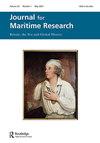Bombing and the geography of Admiralty administration in two world wars
Q3 Arts and Humanities
引用次数: 0
Abstract
ABSTRACT The construction of so many temporary Admiralty offices in St James's Park during the First World War, despite the threat of enemy bombing, shows that British naval administrative efficiency then depended significantly on the close physical proximity of offices, albeit supplemented where necessary by additional liaison mechanisms. Subsequently, however, changing office practices, and advances in communications infrastructure and technology, made it possible for the administration to stretch itself very considerably. That was fortunate, since developments in warfare, including a great increase in the accuracy and weight of bombing attacks, demanded dispersion. By the Second World War, it can be argued there were four different Admiralties in the country, London, Bath, and Western Approaches and Rosyth Commands. They were not quite separate, however, but functionally linked with each other and with numerous other naval establishments, to the degree one could no longer identify Admiralty headquarters geographically; instead, it existed wherever there were officials and officers who carried out Admiralty functions.两次世界大战中轰炸与海军部行政的地理
第一次世界大战期间,尽管有敌人轰炸的威胁,但在圣詹姆斯公园建造了如此多的临时海军部办公室,这表明英国海军的行政效率在很大程度上依赖于办公室的近距离物理距离,尽管必要时还辅以额外的联络机制。但是,后来由于办公室做法的改变以及通讯基础设施和技术的进步,行政部门有可能大大扩大自己的工作范围。这是幸运的,因为战争的发展,包括轰炸的准确性和重量的大大增加,需要分散。到第二次世界大战的时候,可以说英国有四个不同的海军部,伦敦、巴斯、西方方法和罗赛斯司令部。然而,它们并不是完全分开的,而是在功能上相互联系,并与许多其他海军机构联系在一起,以至于人们再也无法在地理上识别海军部总部;相反,它存在于任何有执行海军部职能的官员和军官的地方。
本文章由计算机程序翻译,如有差异,请以英文原文为准。
求助全文
约1分钟内获得全文
求助全文
来源期刊

Journal for Maritime Research
Arts and Humanities-History
自引率
0.00%
发文量
0
期刊介绍:
The Journal for Maritime Research ( JMR ), established by the National Maritime Museum in 1999, focuses on historical enquiry at the intersections of maritime, British and global history. It champions a wide spectrum of innovative research on the maritime past. While the Journal has a particular focus on the British experience, it positions this within broad oceanic and international contexts, encouraging comparative perspectives and interdisciplinary approaches. The journal publishes research essays and reviews around 15-20 new books each year across a broad spectrum of maritime history. All research articles published in this journal undergo rigorous peer review, involving initial editor screening and independent assessment, normally by two anonymous referees.
 求助内容:
求助内容: 应助结果提醒方式:
应助结果提醒方式:


